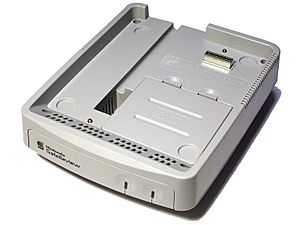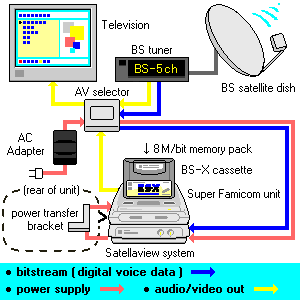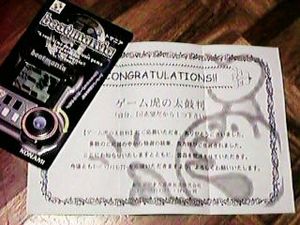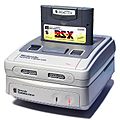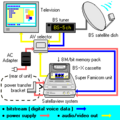Satellaview facts for kids
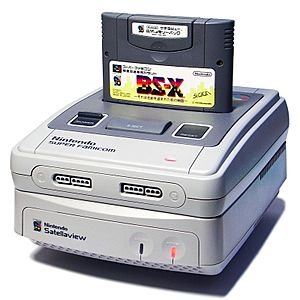
Satellaview and Super Famicom
|
|
| Developer | Nintendo R&D2 St.GIGA |
|---|---|
| Manufacturer | Nintendo |
| Type | Video game console accessory |
| Generation | Fourth generation |
| Release date |
|
| Discontinued |
|
| Media | ROM cartridge, Flash memory |
| Storage | Game Pak, 8M Memory Pak |
| Predecessor | Famicom Disk System |
| Successor | 64DD |
The Satellaview (pronounced Sah-TELL-uh-view) was a special device made by Nintendo for its Super Famicom console in Japan. It came out in 1995. Think of it like an early internet connection for your game console!
This accessory had 1 megabyte of memory and 512 kilobytes of extra RAM. This allowed players to download games, magazines, and other cool stuff. These downloads came through special satellite broadcasts from a Japanese company called St.GIGA. Many game companies, like Squaresoft, Taito, Konami, Capcom, and Seta, made content for it.
To use the Satellaview, players bought a special satellite tuner from St.GIGA or rented one. The Satellaview device connected to the bottom of the Super Famicom.
Nintendo and St.GIGA worked together to create the Satellaview. St.GIGA was known for its "Tide of Sound" music, which featured nature sounds. In 1994, St.GIGA was having money problems, so Nintendo helped them out by buying a part of their company. The Satellaview was made by Nintendo Research & Development 2, the same team that designed the Super Famicom. It was meant for an older audience, not just kids.
Later, Nintendo and St.GIGA had disagreements. Nintendo stopped supporting Satellaview in March 1999. St.GIGA kept providing content until June 30, 2000, when the service completely stopped.
The Satellaview faced challenges because newer, more powerful game consoles like the Sega Saturn, PlayStation, and Nintendo 64 came out. It was also quite expensive and only sold by mail order or in specific stores. Still, St.GIGA reported that over 100,000 people subscribed by March 1997.
Today, people remember the Satellaview for its amazing technology and the quality of its games, especially those from the Legend of Zelda series. Many of its games and content are now considered lost media, meaning they are hard to find. Because of this, video game fans are working hard to find and save these old games and services online.
Contents
How the Satellaview Started
St.GIGA was a company that started in 1990. It was a part of a bigger Japanese satellite TV company called WOWOW, Inc. St.GIGA was the first digital satellite radio station in the world! It was famous for its "Tide of Sound" broadcasts, which were high-quality digital recordings of nature sounds with a narrator.
At first, the company was very successful. They even released music albums and merchandise. But by 1994, St.GIGA started having money troubles. People weren't buying as much ambient music or satellite systems because of a tough economy in Japan. To help them, Nintendo bought a part of St.GIGA in May 1994. This was like a "rescue plan" to help the company get back on its feet.
Making the Satellaview Happen
Work on the Satellaview began soon after Nintendo bought a share of St.GIGA. It was being made at the same time as other famous Nintendo projects like the Virtual Boy and Nintendo 64.
While Nintendo was building the Satellaview device, St.GIGA changed its broadcast schedule. They added a new block called the "Super Famicom Hour." This show gave tips and news for upcoming Super Famicom games. St.GIGA would handle the satellite broadcasts, and Nintendo and other game companies would create games and other content for the service. Nintendo told game magazines that much of the Satellaview's content, especially St.GIGA's broadcasts, was for adults. Video games were only a small part of the broadcast time.
Nintendo officially announced the Satellaview on December 21, 1994. It cost about 14,000 Japanese Yen, which was around $150 in 1994. Many game developers like Capcom, Taito, Konami, Seta, and Squaresoft said they would make games for it. The device was designed by Nintendo Research & Development 2, the same team that made the Super Famicom.
Even though Nintendo was having a slow period with Super Famicom game sales and the Virtual Boy's struggles, the company leaders believed in the Satellaview. Nintendo's president, Hiroshi Yamauchi, hoped to sell about 2 million Satellaview units each year. You could pre-order the Satellaview starting February 25, 1995. The broadcasting service began on April 1, and the device was released on April 23. It was only sold through mail order, not in regular stores.
Why It Stayed in Japan
The Satellaview was never released outside of Japan. Some people think this was because digital satellite broadcasting was very expensive in other countries. Also, it might not have been as popular with players in places like America. When the service first started, St.GIGA had some issues with broadcasting games and services. There were legal problems with other companies and technical limits at the time.
In June 1996, Nintendo even talked about working with Microsoft to create a similar service for Windows computers. This would have combined St.GIGA's broadcasts with internet access, but it never happened. By March 1997, St.GIGA reported that the Satellaview had 116,378 active users.
The End of Satellaview
By mid-1998, Nintendo's relationship with St.GIGA started to get difficult. St.GIGA refused a plan from Nintendo to help them with their money problems, even though they had a lot of debt. They also failed to get an important government license for digital satellite broadcasting.
Because of these issues, Nintendo stopped making new games and content for the Satellaview in March 1999. They also canceled some services. St.GIGA continued to provide content for a while, mostly showing old broadcasts and focusing only on video games. The Satellaview was completely stopped on June 30, 2000. This was because it didn't have much support from other companies and fewer and fewer players were using it. The number of active users dropped by almost 60% from its peak in 1997. One year later, St.GIGA went out of business.
How the Satellaview Worked
The Satellaview device connected to a special port on the bottom of a Super Famicom. It was similar to how the 64DD or the Sega CD connected to their consoles. The Satellaview also helped power the Super Famicom.
This accessory added 1 MB of extra memory and 512 KB of RAM to the Super Famicom. A Satellaview system came with a special power adapter and a video selector. These connected the console to the satellite tuner you needed.
Games and broadcast information were saved on 8 MB memory packs. These packs fit into the top of a special game cartridge. You could rewrite these memory packs with new content. Some Super Famicom games, like RPG Maker 2, could even save things to them. To use the system, a player would buy (or rent) a satellite tuner from St.GIGA, pay monthly fees, and buy a satellite dish.
The main system cartridge for the Satellaview was called BS-X: Sore wa Namae o Nusumareta Machi no Monogatari. This translates to BS-X: The Town Whose Name Was Stolen. This cartridge was both an interactive menu and a game itself! It had a town that looked a bit like the game EarthBound. Different buildings in the town represented the Satellaview's services. Players could create their own character, buy items, play mini-games, read announcements from St.GIGA and Nintendo, and even join contests. This cartridge also gave the Super Famicom more RAM, making it run better.
Games and Services You Could Get
A total of 114 games were released for the Satellaview. Some were new versions of older games, while others were made just for this service. Nintendo's popular game series like Kirby, F-Zero, Fire Emblem, The Legend of Zelda, and Super Mario Bros. all had games on Satellaview. Nintendo also made new games like Sutte Hakkun. The creator of EarthBound, Shigesato Itoi, designed a fishing game called Itoi Shigesato no Bass Tsuri No. 1. A game called Special Tee Shot, which later became Kirby's Dream Course, was also released.
Other companies made games too, such as Squaresoft's Radical Dreamers and Treasure Conflix, Pack-In-Video's Harvest Moon, Chunsoft's Shiren the Wanderer, Jaleco's Super Earth Defense Force, and ASCII's Derby Stallion '96.
A special type of game called "Soundlink games" were broadcast with live voice acting from radio personalities. Unlike other Satellaview games, you could only play SoundLink games at specific times when they were broadcast live. Nintendo often held tournaments for games like Wario's Woods, where players could compete to win prizes.
Besides games, Satellaview subscribers could get many other services. You could read free magazines, including video game magazines like Famitsu and Nintendo Power. There were also general Japanese magazines about news, music, or celebrity interviews. "Soundlink magazines" included commentary, often by famous Japanese personalities. St.GIGA also broadcast its "Tide of Sound" nature ambiance and other music. A special newsletter from both St.GIGA and Nintendo gave updates on contests and upcoming events.
Images for kids
See also
 In Spanish: Satellaview para niños
In Spanish: Satellaview para niños


